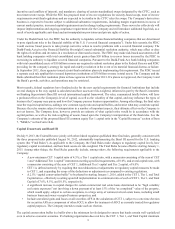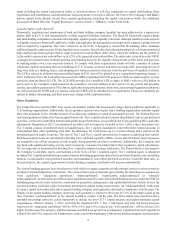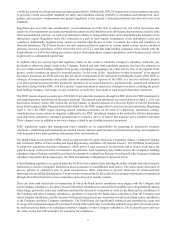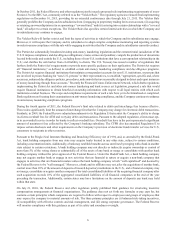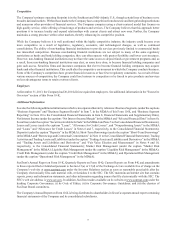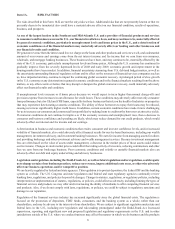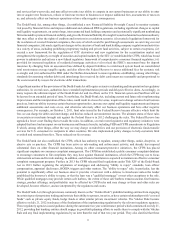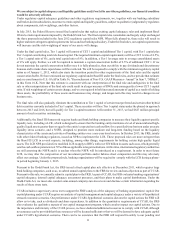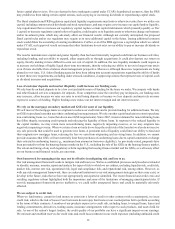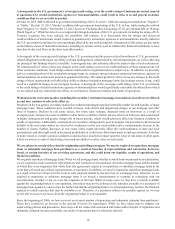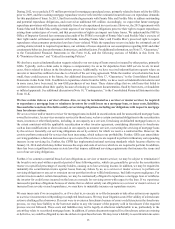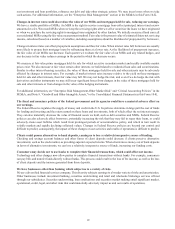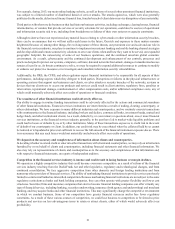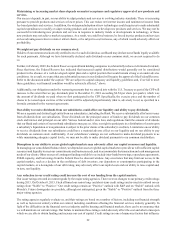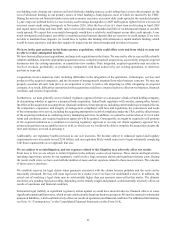SunTrust 2013 Annual Report Download - page 29
Download and view the complete annual report
Please find page 29 of the 2013 SunTrust annual report below. You can navigate through the pages in the report by either clicking on the pages listed below, or by using the keyword search tool below to find specific information within the annual report.13
commitments). This process, which is critical to our financial results and condition, requires difficult, subjective and complex
judgments, including forecasts of economic conditions and how these economic conditions might impair the ability of our
borrowers to repay their loans. As is the case with any such assessments, there is always the chance that we will fail to identify
the proper factors or that we will fail to accurately estimate the impacts of factors that we do identify.
We might underestimate the credit losses inherent in our loan portfolio and have credit losses in excess of the amount reserved.
We might increase the allowance because of changing economic conditions, including falling home prices and higher
unemployment, or other factors such as changes in borrower behavior. As an example, borrowers may discontinue making
payments on their real estate-secured loans if the value of the real estate is less than what they owe, even if they are still
financially able to make the payments.
While we believe that our allowance for credit losses was adequate at December 31, 2013, there is no assurance that it will
be sufficient to cover all incurred credit losses, especially if housing and employment conditions worsen. In the event of
significant deterioration in economic conditions, we may be required to increase reserves in future periods, which would
reduce our earnings. For additional information, see the “Risk Management-Credit Risk Management” and “Critical
Accounting Policies-Allowance for Credit Losses” sections in the MD&A in this Form 10-K.
Our ALLL may not be adequate to cover our eventual losses.
Like other financial institutions, we maintain an ALLL to provide for loan defaults and nonperformance. Our ALLL is based
on our historical loss experience, as well as an evaluation of the risks associated with our loan portfolio, including the size
and composition of the loan portfolio, current economic conditions and geographic concentrations within the portfolio. The
current economic conditions in the U.S. and in our markets could deteriorate, which could result in, among other things, greater
than expected deterioration in credit quality of our loan portfolio or in the value of collateral securing these loans. Our ALLL
may not be adequate to cover eventual loan losses, and future provisions for loan losses could materially and adversely affect
our financial condition and results of operations. Additionally, in order to maximize the collection of loan balances, we
sometimes modify loan terms when there is a reasonable chance that an appropriate modification would allow our client to
continue servicing the debt. If such modifications ultimately are less effective at mitigating loan losses than we expect, we
may incur losses in excess of the specific amount of ALLL associated with a modified loan, and this would result in additional
provision for loan losses.
On December 20, 2012, the FASB issued for public comment a Proposed ASU, Financial Instruments-Credit Losses (Subtopic
825-15) (the Credit Loss Proposal), that would substantially change the accounting for credit losses under U.S. GAAP. Under
U.S. GAAP's current standards, credit losses are not reflected in the financial statements until it is probable that the credit loss
has been incurred. Under the Credit Loss Proposal, an entity would reflect in its financial statements its current estimate of
credit losses on financial assets over the expected life of each financial asset. The Credit Loss Proposal, if adopted as proposed,
may have a negative impact on our reported earnings, capital, regulatory capital ratios, as well as on regulatory limits which
are based on capital (e.g., loans to affiliates) since it would accelerate the recognition of estimated credit losses.
We may have more credit risk and higher credit losses to the extent that our loans are concentrated by loan type,
industry segment, borrower type, or location of the borrower or collateral.
Our credit risk and credit losses can increase if our loans are concentrated in borrowers engaged in the same or similar activities
or in borrowers who as a group may be uniquely or disproportionately affected by economic or market conditions. For example,
we experienced the effect of concentration risk when we incurred greater than expected losses in our residential real estate
loan portfolio due to the latest housing slowdown and greater than expected deterioration in residential real estate values in
many markets, particularly several Florida MSAs. As Florida is our largest banking state in terms of loans and deposits,
deterioration in real estate values and underlying economic conditions in those markets or elsewhere could result in materially
higher credit losses. A deterioration in economic conditions, housing conditions, or real estate values in the markets in which
we operate could result in materially higher credit losses. For additional information, see the "Loans", "Allowance for Credit
Losses", “Risk Management-Credit Risk Management” and “Critical Accounting Policies-Allowance for Credit Losses”
sections in the MD&A and Notes 6 and 7, "Loans" and "Allowance for Credit Losses", to the Consolidated Financial Statements
in this Form 10-K.
We will realize future losses if the proceeds we receive upon liquidation of NPAs are less than the carrying value of
such assets.
NPAs are recorded on our financial statements at the estimated net realizable value that we expect to receive from ultimately
disposing of the assets. We could realize losses in the future as a result of deteriorating market conditions if the proceeds we
receive upon dispositions of NPAs are less than the carrying value of such assets.


